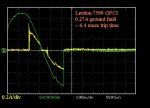Worlds Gr8est Electrician
Member
I had a customer today call and tell me one of her outside gfi's were not working. She said she had another electrician replace it twice already in the lst 6 months. She wanted to see if I could find anything wrong with the circuit he may have missed.
The gfi was being fed from one of the lighting circuits. It had 113v under a 15 amp load. This is not low under 15 amp load, but I was wondering would voltage drop cause a GFI to go bad over time.
I did not find anything else wrong with her circuit that is was being fed from. The bad gfi was leveton weather proof. I replaced it with a cooper which I prefer. Everything was up and running after that. The only other thing I noticed and corrected was her main lug panel had the neutral and ground bonded with a bonding screw which I removed.
The gfi was being fed from one of the lighting circuits. It had 113v under a 15 amp load. This is not low under 15 amp load, but I was wondering would voltage drop cause a GFI to go bad over time.
I did not find anything else wrong with her circuit that is was being fed from. The bad gfi was leveton weather proof. I replaced it with a cooper which I prefer. Everything was up and running after that. The only other thing I noticed and corrected was her main lug panel had the neutral and ground bonded with a bonding screw which I removed.
Last edited:


